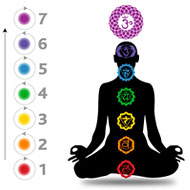- Aromatherapy (36)
- Benefits of Yoga (282)
- Home Remedies (1087)
- massage therapy (9)
- Preventive Therapy (135)
- Running (41)
- Skin Care (15)
- Stress Relief (25)
- Stretching (5)
- walking (33)
- Womens Health (14)
- Yoga Benefits for Pregnant Women (16)
- Yoga Benefits for Students (3)
- Yoga for Children (11)
- Yoga for Holistic Living (37)
- Yoga for Midlife Crisis (3)
- Yoga for Senior Citizens (2)
- Yoga for the Workplace (1)
- Yoga Health Tips (185)
- Yoga Practice during Menstruation (5)
Seven Energy Centers Of Human Body

The seven energy centers of the human body are known as “chakras”. Chakra, which means wheel or circle in Sanskrit, refers to the wheel of life. The chakras are supposed to be aligned along the spine, in an ascending order. Chakras are visualized as lotuses with several petals. Some associate the chakras with colors, while traditionally; these are associated with physiological functions. The chakras or the energy centers of the body, vitalizes the body and fuels the emotional, physiological and mental nature. These chakras are the fountain and source of prana or energy, which is believed to flow through the body in nadis or pathways. The chakras are supposed to draw in the force and life energy and balance the health of the body. The concept of chakras was first found in the Upanishads, holy Hindu texts.
There Are Seven Basic Chakras:
- Sahasrara: This is the crown chakra, which are the chakra of consciousness and the most important chakra that controls all the others. The role of Sahasrara is similar to the role of the pituitary gland. This gland secretes certain hormones that control the endocrinal system. The pituitary also connects the nervous system through the hypothalamus. Sahasrara is shown as a lotus with a thousand petals.
- Ajna: The third eye is supposed to be connected to the pineal gland that produces melatonin – a hormone that regulates sleeping and awakening. This is the symbol of time, light and awareness. This chakra is shown as a lotus with two petals.
- Vishuddha: The throat chakra is about growth, expression and communication. It is symbolic of the thyroid gland in the throat – the hormone that this gland produces, is responsible for maturation and growth. Vishuddha is shown as a lotus with sixteen petals.
- Anahata: This chakra is related to the heart and emotions, love, balance and well-being. Anahata is symbolic of the thymus gland in the chest that looks after the immune system and general well-being. It is shown as a lotus with twelve petals.
- Manipura: This chakra which is symbolic of the solar plexus is related to digestion, energy and assimilation. It is the parallel of the pancreas and the adrenal cortex – organs and glands that help in digestion and energy-creation. A lotus with ten petals is how this chakra is depicted.
- Swadhisthana: The sacral chakra is believed to be located in the groin and is responsible for sexuality. The reproductive organs are what this chakra is supposed to look after. This chakra is symbolized by a lotus with six petals.
- Muladhara: This base chakra is connected to survival, security and potentiality. It is situated between the genitals and the anus. It is said to be connected to the inner adrenal glands. It is shown as a lotus with four petals.
- RSS Feeds -
- All posts
- All comments
- Healing Touch Therapy Therapeutic Touch TherapyTherapeutic touch therapy or healing hands ...
- People Unaware Of Yoga People who don't practice Yoga and are undergoing stress had about time ...
- Yoga for Depression Yoga is beneficial in many ways and doing yoga for depression is just one of ...
- Inhaling vapors from essential oil Aromatic essential oils are used in a lot of different therapeutic scenarios....